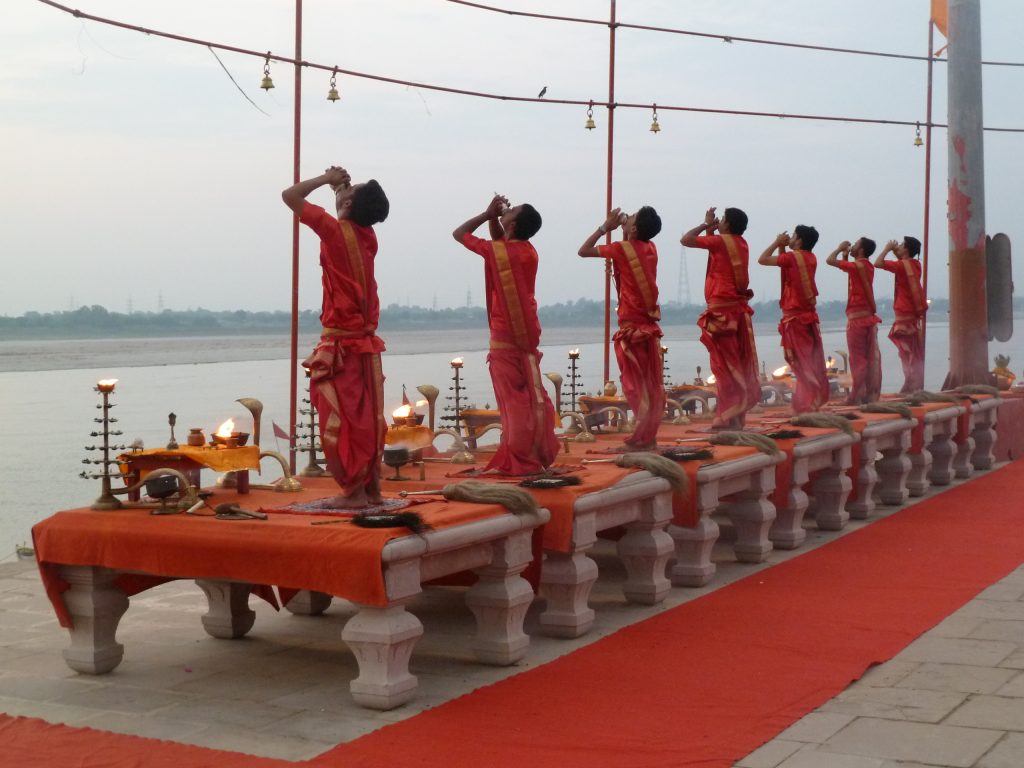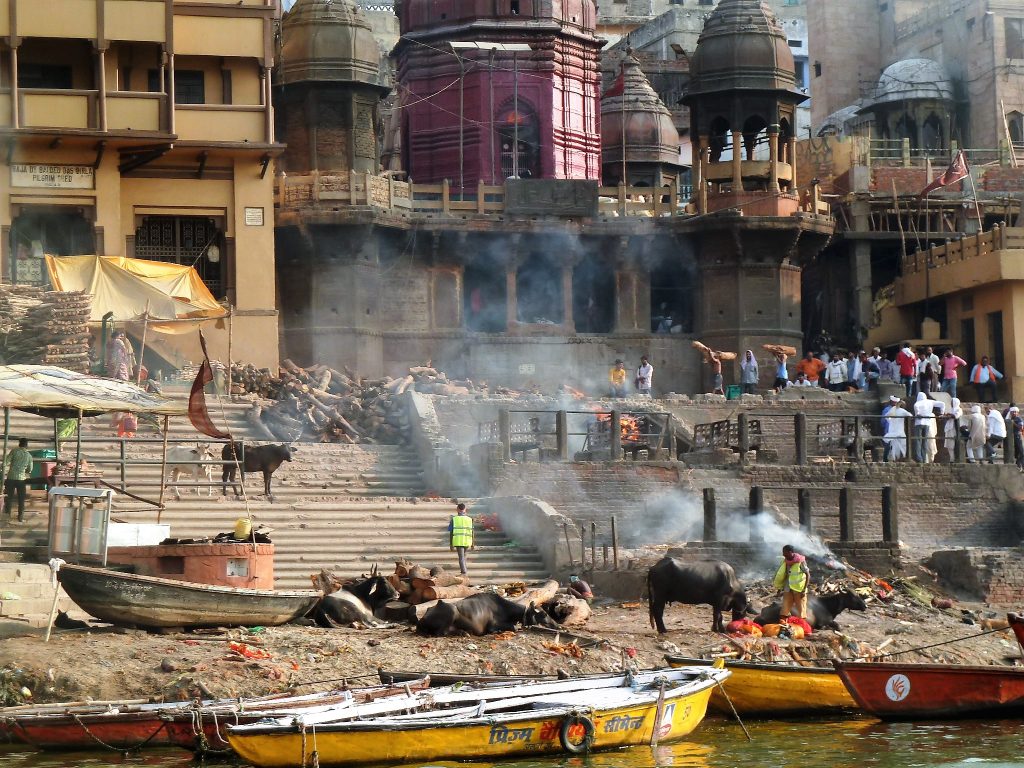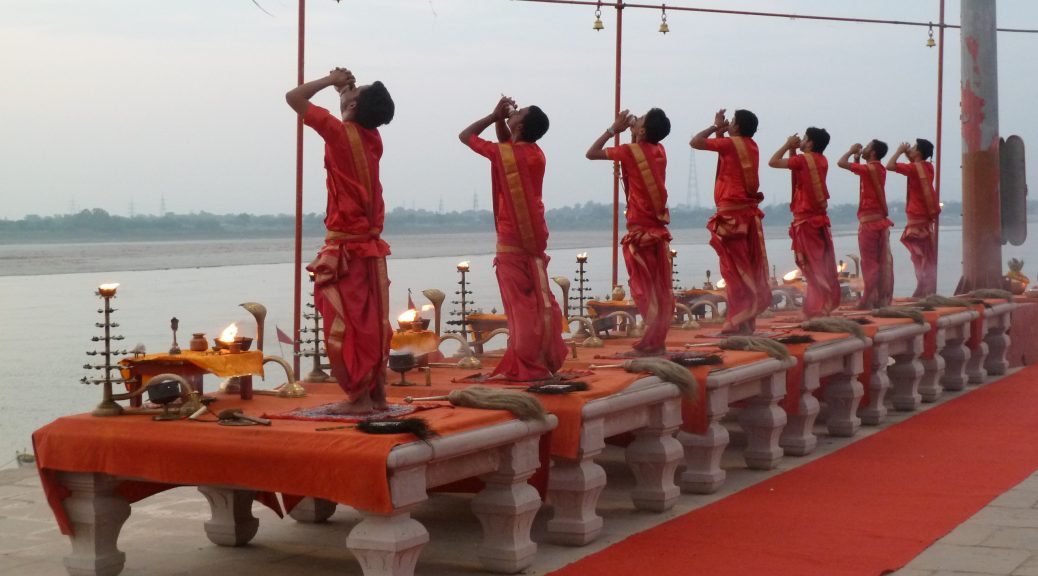Banaras is a sacred city that has a rich history. The city goes by various other names such Varanasi and Benares. The city is also called Kasi, which can be translated to the city of light, emphasizing its reputation among Hindus (Eck 3). Originally, the city was called Varanasi, which was the capital of the ancient kingdom of Kasi; this is elucidated in Buddhist literature, in the Jatakas (Eck 45). Evidence from the Mahabharata suggests the name Varanasi has its roots in its proximity to the Varana river and the Asi river, which eventually combine into the Ganges river system (Sukul 16). Early Vedic literature such as the Vamana Purana, associates the two rivers as originating as body parts of the cosmic being Purusa, with the Varana river representing a right foot and the Asi river a left foot (Eck 27).
Evidence of the location of Banaras along the banks of the Ganges river, date back to 2nd century BCE. and further evidence suggests this locality continued through the Gupta period in the 6th century CE (Sukul 3). The ancient city was filled with narrow streets, houses, gardens, and temples and has been confirmed through excavations of the much older, northern area of Varanasi situated on Rajghat plateau (Sukul 5-6). This city layout continued in later times as Varanasi expanded. It was common in northern India to build cities with this type of city planning structure (Sukul 6-7).

Following the year 1035 CE a series of outside influences affected Varanasi. This included looters, and attempted campaigns against the city by Muslim conquerors (Sukul 4). These early influences also led to pockets of Muslim communities springing up within Varanasi while under Hindu rulers, from the 11th and 12th centuries (Sukul 5). Later, there were other Muslim conquerors who came and looted the city, while also destroying many temples; again this Islamic influence is characterized by the Muslim communities present today in much of northern Banaras (Sukul 6).
Buddhism was also prominent in the region, particularly in Sarnath, but also in the nearby Varanasi where the Buddhist tradition flourished up until the 12th century when the region was conquered by Qutb-ud-din Aibak (Eck 57). During this period both cities had sacred sites destroyed, however the Buddhist tradition in these areas did not recover (Eck 57). In the 500-year occupation of Muslim rule starting from the Delhi Sultanate in 1206 CE, a general loss of religious history is recognized through the destruction of many sacred sites (Eck 83). However, despite many important sites being destroyed, the region still served as a hub of religious and intellectual endeavors (Eck 84). Even through British occupation starting in the late 18th century, the Hindu tradition in the region remained strong (Eck 92-93).
The earliest speculated reign of Aryans in the kingdom of Kasi is between 1800 BCE and 2000 BCE. This reign is assumed to have followed a conquest led by Videgha Mathava, which is mentioned in the Shatpatha Brahmana (Sukul 18). It is speculated that this conquest was the start of the prominence of Aryan influence in the region over the indigenous inhabitants (Sukul 17). Following this, Varanasi went through a progression of control under different kings. Notably king Dhritarashtra is recognized as one of the earliest rulers (Sukul 23). During this period, the city became a hub of commerce, artisan trades, agriculture, asceticism, and philosophy, all under the influence of Vedic teachings (Sukul 24). Naturally these Vedic teachings affected the entire political structure of Varanasi with different classes being associated with certain roles in society. These Vedic influences tie into the sacredness of the city particularly its association with Siva, other deities, and prominent myths.
Even before Aryan influence in the area, non-Aryan groups living around Varanasi already had an established mythology. Ancient deities associated with aspects of nature such as trees and pools existed throughout the region (Eck 51). These deities varied greatly among different localities and were not worshipped in grand temples as seen with some Vedic deities (Eck 51). Aspects of worship in these early non-Aryan traditions are still present today. For example, many of the food offerings associated with these deities have been translated into use in Puja ceremonies (Eck 52). Similarly, blood offerings have changed to smearing icons with red vermillion coloring (Eck 52). Many of these local deities or yaksas became associated with greater Vedic deities. For example, many yaksas became part of groups, or ganas, associated with Siva, they were essentially seen as henchman of Siva (Eck 61, 68).
As Aryan influence increased, myths of greater Vedic gods became further established in the region. Among this range of mythological accounts, Siva searching for a home in Varanasi stands out. The myth tells of a recently married Siva looking for a suitable home for himself and his new wife Parvati (Eck 53-54). Siva finds Varanasi to be the only suitable location, however the city was already under control by king Divodasa (Eck 54). In order to oust the king from the city Siva sends deities from the entire pantheon to help him. One myth tells of Siva sending a deity named Nikumbha to aid him (Eck 54). Nikumbha builds a following of worshippers in Varanasi and eventually tricks the king into destroying one of his shrines (Eck 54). The destruction of this shrine forces the king to leave the city as he becomes cursed (Eck 54). In another account, after many deities fail to oust the king and end up staying behind in the city, Siva calls on Visnu. Visnu takes the form of a Buddhist monk, causes disorder in the city and counsels the king (Eck 155). The king, under the counsel of Visnu and seeking an end to the chaos, eventually creates and worships a linga for Siva in exchange for a high place in heaven, thus leaving Varanasi for Siva (Eck 155).
The sacredness of Varanasi is extoled by a popular myth in the Kasi Khanda, of Siva being cleared of sin when he first enters the region. The myth follows Siva taking the form of Bhairava and cutting off one of the five heads of Brahma after he was slandered by him (Eck 108). It is seen as a major sin to kill a Brahmin, and this sentiment was represented by Bhairava being unable to get the decapitated head of Brahma off his hand (Eck 108). Bhairava travels across India until he eventually reaches Varanasi where the head finally drops from his hand (Eck 108). This myth ties into the idea that one goes to Varanasi to cleanse themselves of sin and relates to the pilgrimage traditions in the region (Eck 108).
Of the many mythological accounts surrounding Siva and Banaras, there is a clear connection between the two. Within Banaras there are hundreds of temples and lingas, which are emblems of Siva, dedicated to him that are worshiped by Hindus (Eck 103). Furthermore, based on the mythology there is a clear connection of the entire pantheon of deities to Banaras. Many other gods such as Visnu, Devi, Durga, Hanuman, Ganesa, among others are worshipped vehemently in Banaras. A noteworthy deity is Kala Bhairava who is considered a form of Siva, and in some representations as a son of Siva (Eck 190). Bhairava is a manifestation of the terrible qualities of Siva, and Kala is etymologically related to death and fate (Eck 190). This combination of qualities warrants the role of the deity as the god of death and officer of justice in Varanasi (Eck 190-192). Yama is another well-known god of death in the pantheon of deities, but is unable to enter Varanasi, thus Bhairava fills the role and punishes and collects souls (Eck 193). It is said that all those who die in Varanasi will face the punishment of Bhairava or bhairavi yatana (Eck 193).

Themes of life in accordance to Hindu tradition are prominent in Banaras, represented by mythological accounts and everyday life within the city. Banaras is referred to as a great mine that carries the jewels of dharma, artha, kama, and moksa (Eck 306). Respectively, each of these names corresponds to one of the aims of life in the Hindu tradition. Kama is related to the pursuit of pleasure, passion and desire (Eck 306). Kama goes beyond sexual pleasure, it can be applied to anything people do, as long as what they pursue is based on their love for doing their activities (Eck 307). The pursuit of kama is evident in the rich traditions of music, and dance of Varanasi as well as in the mythological accounts of Siva who, although he was an ascetic, loved and pursued Varanasi with a fierce passion (Eck 309-310). Artha is referred to as a purpose, it usually refers to the pursuit of something useful that provides power and wealth (Eck 310). The Kasi Khanda suggests that the power of the universe originates in Kasi (Eck 310). In relation to wealth, as noted earlier, Varanasi has been a hub of commerce and wealth throughout its history (Eck 310). Dharma is related to living in accordance with the cosmic order or laws in Hinduism, this includes many rites involving the stage in one’s life cycle, sacrificial rites, rites for death, among others (Eck 314). Varanasi is viewed as bringing these various rites to fulfillment and amplifying the benefits of any ritual action (Eck 315). Simply to live in Banaras may be seen as fulfilling dharma (Eck 322). From these notions we can see that Banaras extols these themes of life present in the Hindu tradition.

The theme of death is strong in the city of Banaras, it is seen as common, inevitable, and as a process of transformation (Eck 325). Manikarnika, viewed as a sanctuary of death, home to the main cremation pyres in the city, lies in the center of Banaras (Eck 324). Death in Varanasi offers moksa or liberation from samsara, the cycle of birth and death (Eck 325). This last stage of life may be associated with renouncers and ascetics but is also pursued by others. Many come to Varanasi anticipating their coming death and wait in hospice (Eck 329). In this sense Varanasi is seen as the final destination in a pilgrimage represented by life and is pursued by Hindus from various different backgrounds (Eck 329). When death comes it is thought that Siva will say the taraka mantra, to the deceased granting them liberation from samsara (Eck 332).
There are a number of rituals and festivities in Banaras, all cannot be covered here. The cremation rite known as antyesti or the last sacrifice, may be one of the more well-known rituals of Banaras (Eck 340). It involves a procession of people carrying the deceased through the streets and chanting, then dipping the body in the Ganges river, after this, the body is adorned with flowers and sandalwood oil (Eck 340). A chief mourner, who is usually the eldest son of the deceased, takes twigs that come from the holy kusa grass; these twigs are lit by an eternal sacred fire (Eck 341). Flaming twigs in hand, the chief mourner circles the pyre counterclockwise then lights the pyre (Eck 341). Once the body is almost completely cremated the chief mourner cracks the skull of the deceased by hitting it with a bamboo stick (Eck 341). This is viewed as releasing the soul from the body (Eck 341). Finally, water from the Ganges river is put in a clay pot and thrown over the left shoulder of the chief mourner onto the remaining embers (Eck 341). The chief mourner then walks away without looking back (Eck 341). What follows the cremation is eleven days of offerings of rice balls to the dead (Eck 341). Finally, on the twelfth day, it is believed that the soul of the deceased has reached the heavens (Eck 341-342). Many of the festivities that take place in Banaras are based on the time of year and the seasons. Some of these festivities include the Makara Samkranti, which is akin to a winter solstice celebration, the Maha Sivaratri, which celebrates the marriage day of Siva, and the Chaita Navaratri, which celebrates the new year in the Hindu calendar, among countless other festivities (Singh, Pravin, and Shastri Indo-Canadian Institute 70-71).
REFERENCES AND FURTHER RECOMMENDED READINGS
Eck, Diana L (1983) Banaras: City of Light. Princeton: Princeton University Press.
Hertel, Bradley R., Humes, Cynthia A., & Shastri Indo-Canadian Institute (1998) Living Banaras: Hindu religion in cultural context. New Delhi: Manohar.
Parry, Jonathan P (1994) Death in Banaras. Cambridge: Cambridge University Press.
Singh, Rana P. B., Pravin, Rana S., and Shastri Indo-Canadian Institute (2002) Banaras Region: A Spiritual & Cultural Guide. Varanasi: Indica Books.
Sukul, Kuber N (1974) Varanasi down the ages. Patna: Kameshwar Nath Sukul.
Related Topics for Further Investigation
Chaita Navaratri
Devi
Dhritarashtra
Durga
Dividosa
Doms
Five Faces of Siva
Ganesa
Ganges
Kusa
Lingas
Makara Samkranti
Manikarnika
Parvati
Puja
Rajgat Plateau
Saivism
Siva
Surya
Visnu
Noteworthy Websites Related to the Topic
https://www.britannica.com/place/Varanasi
https://en.wikipedia.org/wiki/Kingdom_of_Kashi
https://en.wikipedia.org/wiki/Benares_State
https://www.bbc.com/news/world-asia-india-26727261
Article written by: Zahin Mohammed (Spring 2020) who is entirely responsible for its content.
